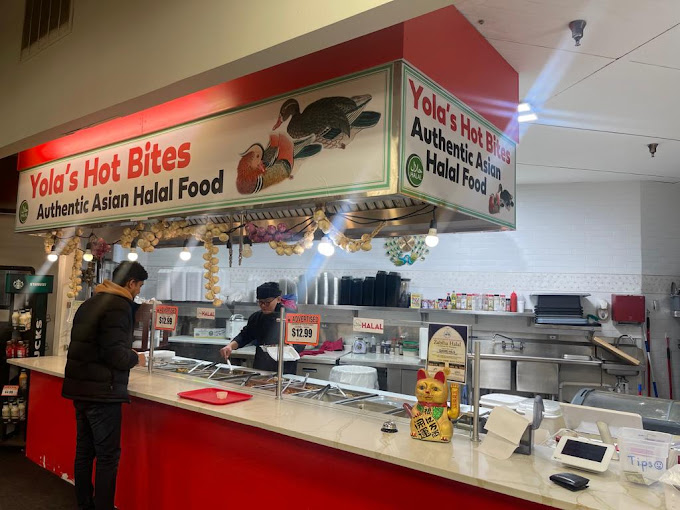Asian Restaurant ISB: A Must-Try Place for Food Lovers in Islamabad
Asian Restaurant ISB: A Must-Try Place for Food Lovers in Islamabad
Blog Article
Savor Authentic Eastern Cuisine With a Pan-Asian Twist for a Culinary Experience
Embarking on a cooking journey via authentic Asian cuisine, improved with a Pan-Asian spin, supplies an one-of-a-kind chance to explore the abundant tapestry of flavors that specify the region's diverse culinary customs. This experience welcomes you to appreciate the beautiful equilibrium of tastes-- wonderful, salty, spicy, and sour-- integrated by fragrant natural herbs and flavors. Envision the cutting-edge blend of Thai curry and ramen or the unanticipated joy of sushi burritos. As you consider these attracting dishes, take into consideration the cultural stories and historical impacts that form them, each bite using a story waiting to be discovered.

Exploring Pan-Asian Flavors
In the realm of global gastronomy, Pan-Asian cuisine attracts attention for its amazing diversity and the unified interplay of flavors from various Asian societies. This cooking strategy celebrates the unique ingredients and rich customs found across the continent, developing a tapestry of preferences that is both intriguing and enjoyable. Key to Pan-Asian cuisine is its capacity to stabilize different flavors-- pleasant, salty, spicy, and sour-- while highlighting the quality and top quality of each component.
From the umami-rich soy sauce of Japan to the intense chili peppers of Thailand, Pan-Asian food supplies an extensive scheme of tastes. These aspects are often incorporated in inventive means, improving dishes with layers of intricacy. For instance, making use of aromatic natural herbs such as lemongrass and cilantro, usual in Vietnamese and Thai food, includes a revitalizing illumination to meals, while the unification of coconut milk delivers a velvety, rich appearance.
The emphasis on fresh produce and aromatic spices guarantees that each meal is not just a feast for the palate yet likewise for the detects. Pan-Asian cuisine welcomes diners to get started on a cooking trip, checking out the vast and varied landscapes of Asian gastronomy with every bite.
Fusion Dishes to Try
While Pan-Asian food is celebrated for its typical tastes, the modern cooking landscape is progressively accepting combination dishes that blend these classic aspects with impacts from other areas. This cutting-edge method not just honors the rich heritage of Eastern cookeries but additionally introduces unique preference experiences that attract modern palates.
A prime example of such a blend dish is the Korean-Mexican taco, where seasoned bulgogi beef is covered in a warm tortilla, topped with kimchi and a zesty gochujang-infused salsa. This combination marries the strong, tasty tastes of Korea with the vibrant, fresh aspects of Mexican food. Similarly, sushi burritos have obtained popularity, integrating the fragile virtuosity of Japanese sushi with the hearty, hand-held benefit of a burrito, often featuring blend ingredients like tempura shrimp and avocado with a drizzle of wasabi mayo.
Another notable meal is Thai curry ramen, which instills the creamy, aromatic seasonings of Thai curry into the calming broth of traditional Japanese ramen, producing an unified mix that entices the detects. These blend recipes expand beyond mere novelty; they represent a culinary dialogue between cultures, encouraging exploration and advancement worldwide of Pan-Asian food.
Crucial Active Ingredients and Seasonings
To genuinely value Pan-Asian food, one must understand the important components and flavors that develop its foundation. This varied cooking style attracts from a rich tapestry of Asian practices, utilizing a harmonious mix of flavors and appearances.
Fragrant aspects are pivotal, with garlic, ginger, and lemongrass being common across numerous Pan-Asian recipes. These active ingredients supply a fragrant base that improves the complexity of tastes. Spices such as celebrity anise, cardamom, and cinnamon present warmth and character, echoing influences from areas like China and India.

Food Preparation Strategies and Tips
Mastering the art of Pan-Asian have a peek at this site food requires experience with its distinct food preparation strategies, each adding to the dynamic tapestry of tastes this cooking practice is celebrated for. Central to these techniques is the stir-fry, a quick food preparation strategy that maintains the dietary integrity and vivid colors of ingredients. Utilizing a wok, the stir-fry approach allows for also heat distribution, vital for attaining the characteristic structure and flavor equilibrium of Pan-Asian recipes.
One more fundamental method is steaming, specifically widespread in Chinese food. This mild approach keeps the all-natural tastes and nutrients of active ingredients, making it ideal for fish and shellfish and veggies. Dumplings, a precious staple, commonly take advantage of steaming, resulting in soft, delicious appearances.
Barbecuing, also integral, presents smoky midsts to dishes such as Korean bulgogi or Japanese yakitori (pan asian restaurant Islamabad). This method typically includes marinading components, enabling flavors to pass through deeply before cooking over an open fire or warmer
Lastly, understanding the art of balancing tastes-- wonderful, sour, salty, bitter, and umami-- is critical. Effectively layering these aspects can elevate a recipe from ordinary to phenomenal, supplying a complex and pleasing culinary experience that embodies the essence of Pan-Asian cuisine.
Eating Experiences Worldwide
Around the world, Pan-Asian food uses an unparalleled eating experience, celebrated for its rich tapestry of flavors and vibrant presentations. This culinary sensation has transcended social borders, capturing the hearts and tastes buds of food lovers worldwide. In cosmopolitan cities fresh York, London, and Sydney, Pan-Asian dining establishments offer as fusions where culinary practices from Thailand, Japan, China, and beyond assemble, offering restaurants with a diverse mix of dishes that highlight the region's variety.
The global charm of Pan-Asian food exists in its ability to brooklyn pizza use both authenticity and innovation. Chefs masterfully marry typical ingredients such as lemongrass, soy sauce, and miso with contemporary methods, leading to meals that are both refreshingly brand-new and acquainted. This blend enables restaurants to start a cooking journey that values heritage while embracing modernity.
In addition, dining experiences are boosted via thoughtfully created settings that mirror the principles of Pan-Asian aesthetic appeals. From minimalist Japanese-inspired insides to vivid Thai-themed rooms, each dining establishment uses a special atmosphere that complements the culinary offerings. Because of this, clients are not just taking in a dish yet partaking in a social experience, making Pan-Asian dining a truly international sensation.
Conclusion
The expedition of Pan-Asian food offers an extensive understanding of the intricate interplay of flavors and cooking practices across Asia. By embracing blend meals such as Thai curry ramen and sushi burritos, the culinary trip not only highlights the adaptability of typical active ingredients however also showcases cutting-edge contemporary Check Out Your URL techniques. This gastronomic journey, enhanced by cooking approaches and crucial flavors, provides an one-of-a-kind chance to appreciate the multiculturalism and cooking artistry that define Pan-Asian food on a worldwide range.
Beginning on a cooking journey through genuine Oriental food, enhanced with a Pan-Asian spin, provides an one-of-a-kind chance to explore the abundant tapestry of flavors that define the area's diverse culinary traditions.In the realm of international gastronomy, Pan-Asian cuisine stands out for its amazing variety and the harmonious interaction of flavors from different Eastern cultures. Key to Pan-Asian cuisine is its capacity to balance different flavors-- pleasant, salted, spicy, and sour-- while highlighting the freshness and top quality of each ingredient.

Report this page